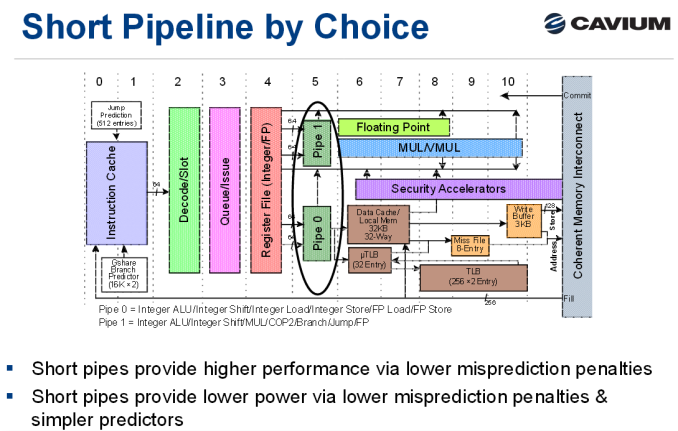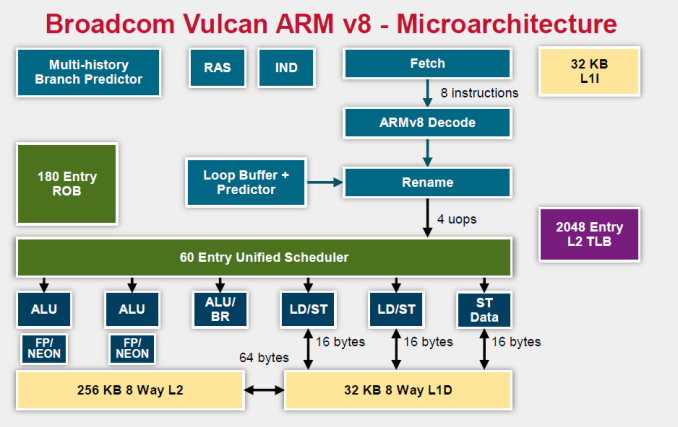Assessing Cavium's ThunderX2: The Arm Server Dream Realized At Last
by Johan De Gelas on May 23, 2018 9:00 AM EST- Posted in
- CPUs
- Arm
- Enterprise
- SoCs
- Enterprise CPUs
- ARMv8
- Cavium
- ThunderX
- ThunderX2
ThunderX: From Small & Simple to Wide & Complex
As a brief recap, the original ThunderX was an improved version of the Octeon III: a dual-issue in-order CPU core with two short pipelines.
The advantage of the original ThunderX design is that such a simple core can be very energy efficient, especially for "low ILP" (instruction level parallelism) workloads such as web servers and most database servers. Of course, such a short pipeline limits the clockspeed, and such a simple in-order design offers low single threaded performance in medium and high ILP workloads, whereas more advanced out-of-order processors can extract significant parallelism.
Cavium's "New" Core: Vulcan
Relative to the original ThunderX, the Vulcan core of the ThunderX2 is an entirely different beast. Announced in 2014 by Broadcom, it is a relatively wide core that runs 4 simultaneous threads (SMT4). As a result, the wide back end should be quite busy even when running low-ILP server workloads.
To make sure that all 4 SMT threads can be sustained, the ThunderX2 front-end can fetch up to 64 bytes from the 8-way set associative 32 KB instruction cache, which is outfitted with a simple next line prefetcher. However, fetching 8 instructions is only possible if there is no taken branch inside those 64 bytes. In that case, the fetch breaks off at the taken branch.
That means that in branch intensive code (databases, AI...) the fetcher will get +/- 5 instructions per clock cycle on average, as one out of 5 instructions is a branch. The fetched instructions are then sent to a smoothing buffer – a buffer where the fetched instructions are held for decoding.
The decoder will then work on a bundle of 4 instructions. Between the decoder and the rename phase each thread has "skid buffer" which consists of 8 bundles. So between the 4 threads up to 32 bundles (128 instructions) can be skid buffered at any one time..
Those 4 instructions – a bundle – travel together through the pipeline until they reach the unified issue queue of the scheduler. Just like Intel has implemented in Nehalem, there is also a loop buffer and predictor, which Intel used to call a "Loop Stream Detector". This loop buffer avoids branch mispredictions and contains decoded µops, which "shortens" the pipeline and reduces the amount of power spent on decoding.
Overall, up to 6 instructions can be executed at the same time. This is divided into 2 ALU/FP/NEON slots, 1 ALU/branch slot, 2 load/store slots (16 bytes), and 1 pure store slot that sends 16 bytes to the D-cache. There is a small (Cavium would not disclose how small) L1 TLB for zero latency translation from Virtual to physical addresses. There is no hardware prefetcher for the L1 D-cache, but the L2 cache has a rather complex hardware prefetcher which is able to recognize patterns (besides being able to stride or fetching the next line).
This is enough to feed the back-end, which can sustain 4 instructions per cycle from 4 different threads.
Micro Architecture Differences
Ultimately Cavium has only published a limited amount of information on the ThunderX2 cores, so there are some limits to our knowledge. But we've gone ahead and summarized some of the key specifications of the different CPU architectures below.
| Feature | Cavium ThunderX2 |
Qualcomm Centriq "Falkor" |
Intel "Skylake"-SP |
AMD EPYC "Zen" |
| L1-I cache Associativity |
32 KB 8-way |
64KB 8-way (+ 24 KB L0) |
32 KB 8-way |
64KB 4-way |
| L1-D cache Associativity |
32 KB 8-way |
32 KB 8-way* |
32 KB 8-way |
32 KB 8-way |
| Load Bandwith | 2x 16B | 2x 16B | 2x 32B | 2x 16B |
| L2-cache | 256 KB 8-way |
256 KB 8-way |
1 MB 16-way |
512 KB 8-way |
| Fetch Width | 8 instructions | 4 instructions | 16 bytes (+/- 4-5 x86) | 32 bytes (+/- 6-8 x86) |
| Issue Queue | 60 | 76 | 97 unified | 6x14 |
| Sustainable Instructions/cycle | 4 | 4 | 5-6 | 4-5 |
| Instructions in Flight | 180 (ROB) | 128 | 224 (ROB) | 192 |
| Int. Pipeline Length |
? |
15 stages | 19 stages 14 stage from µop cache |
19 stages? |
| TLB Instructions TLB Data |
"Small L1" + 2048 unified L2 | ? 64+512 |
128 64 +1536 Unified |
8+64+512 64+1532 |
A detailed analysis is out of the scope of this article. But you can read Ian's analyses of the Falkor, Skylake and Zen architectures here at AnandTech. We limit ourselves to the most obvious differences.
It is pretty clear that Intel's single-threaded performance remains unchallenged: the Skylake core is the widest core, keeps the most instructions in flight, and most importantly runs at the highest clockspeed. The ThunderX2 core is the one that fetches the most instructions per cycle, as it has to be able to keep 4 threads running. The fetch unit will grab 8 instructions from one thread, than grab 8 from the second thread and it will keep cycling between threads. A bad prediction could thus lower the performance of single thread significantly.













97 Comments
View All Comments
name99 - Thursday, May 24, 2018 - link
For crying out loud!At the very least, if you want to pursue this obsession regarding vectors, look at ARM's SVE (Scalable Vector Extensions). THAT is where ARM is headed in the vector space.
Fujitsu is implementing these for the cores of its next HPC machines, and they will likely roll out into other ARM cores (maybe Apple first? but who can be sure?) over the next few years.
To the extent that Cavium has any interest in competing in HPC, if/when they choose to do so it will be on the basis of an SVE implementation, not on the basis of NEON.
Meanwhile ARMv8 NEON is very much the equivalent of SSE. Not AVX, no, but SSE (in all its versions) yes.
tuxRoller - Thursday, May 24, 2018 - link
Nice comment.BTW, centriq (rip) only supports(ed) aarch64. I've no idea how much die space that saved, though.
Wilco1 - Thursday, May 24, 2018 - link
There is Cortex-A35, smallest AArch64 core so far with FP and Neon.However there are still big differences between RISC and CISC. For example it's not feasible for CISC to get anywhere near the same size/perf/power. The mobile Atom debacle has clearly shown it's not feasible to match small and efficient RISCs even with a better process and many billions of dollars...
peevee - Thursday, May 24, 2018 - link
It is not 8.2.lmcd - Wednesday, January 23, 2019 - link
Necro but worth for historic reasons: A35 is AArch32 but ARMv8ZolaIII - Thursday, May 24, 2018 - link
It would took them a same. AVX is a SIMD FP extension to the prime architectural instruction set same as NEON and cetera. The strict difference between CISC and RISC architecture is long gone and today's one's are combined & further more implement IVIL SIMDs and more & more of DSP components as MAC's. The train only starts on prime integer instruction set (where by the way ARM is stellar) and then switches it's worker's to FP extensions and accelerated blocks of different kinds. The same way lintel grow up AVX to 512 bit in current use NEON can be scaled up & beyond. Fuitsu worked with ARM on 1024 & 2048 NEON SIMD blocks couple of years ago. Still if you think how FP is a best way to do it you are wrong, DSP's use CP and it's much more efficient power & performance wise but less scalable.On what would you like server's to be compared? Almost 90% of enterprise servers run on Linux, even Microsoft is earning more money this day's on Linux than from selling Windows desktop & server's combined.
You are very ignorant person. Why do you coment about the things you don't know anything about?
Ryan Smith - Thursday, May 24, 2018 - link
"I really think Anandtech needs to branch into different websites. Its very strange and unappealing to certain users to have business/consumer/random reviews/phone info all bunched together."Although I appreciate the feedback, I must admit that we enjoy doing a variety of things. There are a lot of cool things happening in the technology world, not all of which are in the consumer space. So rare articles like these - and we only publish a few a year - let us keep tabs on what's going on in some of those other markets.
HStewart - Wednesday, May 23, 2018 - link
I would think that a lot of this depends what type of applications are running on server. Highly mathematical and especially any with Vectors will be likely different. Also there is no support for Windows based servers which limits which applications can be done - so my guess this will be useless if desiring a VMWave server.But it is interesting that it takes a 4SMT to compete with x86 based servers from Intel and AMD and with more cores 32 vs 22/28 depending on version.
Wilco1 - Wednesday, May 23, 2018 - link
You're right, on floating point and vectors the results are different. To be precise - even more impressive. See the last page for example where it soundly beats Skylake on OpenFoam and a few other HPC benchmarks. Hence the huge interest from all the HPC companies.Note Windows has been running on Arm for quite some time. Microsoft runs Windows Server both on Centriq and ThunderX2. See eg. https://www.youtube.com/watch?v=uF1B5FfFLSA for more info.
HStewart - Wednesday, May 23, 2018 - link
Windows on ARM is DOA,